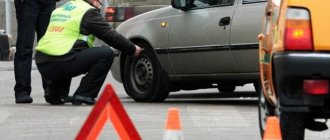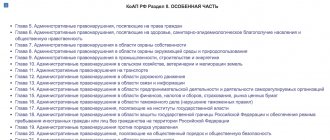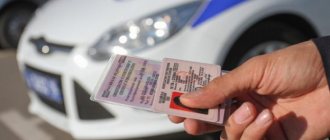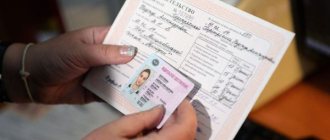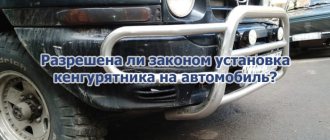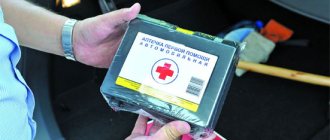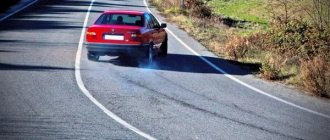A frameless child seat is more affordable, but its use is controversial. Whether it’s possible or not, let’s try to figure it out in this article.
Dear readers! The article talks about typical ways to resolve legal issues, but each case is individual. If you want to find out how to solve your particular problem , contact a consultant:
+7 (499) 938-81-90 (Moscow)
+7 (812) 467-32-77 (Saint Petersburg)
8 (800) 301-79-36 (Regions)
APPLICATIONS AND CALLS ARE ACCEPTED 24/7 and 7 days a week.
It's fast and FREE !
Concept
Regarding a child's frameless car seat, it should be clarified that this is a restraint device that is shaped like a chair, but does not have a rigid frame.
It is attached to the standard car seat using belts.
Available:
- headrest;
- soft back;
- and a seat.
There are five-point harnesses in front designed to secure a small passenger. A standard seat belt is also used - it is pulled through the front of the car seat, fastening the child.
Legislation
To find out whether a frameless child car seat is allowed by the traffic police, you need to refer to the legislation.
- According to clause 22.9 of the traffic rules , for small passengers under 12 years old, it is required to install restraint devices selected for weight and height.
- Frameless car seats are those that are confirmed by GOST 41.44-2005 (approved by order of Rostechregulirovanie No. 318 of December 20, 2005 ).
If there is a child in the car, the traffic police inspector will check for the presence of a child restraint when stopping the car. He also has the right to check whether the seat is secured with seat belts and whether the weight of the young passenger is suitable.
If violations are detected, a fine of RUB 3,000 will be issued. in accordance with Art. 12.23 Code of Administrative Offenses of the Russian Federation.
What car seats are allowed by the traffic police in 2021?
«22.9.
Transportation of children under the age of 7 years in a car and truck cab, which are designed with seat belts or seat belts and an ISOFIX* child restraint system, must be carried out using appropriate weight and height of the child. But, we repeat, this applies to children under 7 years.
If the child is older, but he is still not old enough to fasten him securely with a regular seat belt in the back seat, no one prohibits you from using child devices either.
But no one forces you.
- GOST standards regulate all the necessary requirements for child restraint devices (CDUs) that can be used to transport children.
- The Code of Administrative Offenses of the Russian Federation (CAO RF) determines the punishment for transporting children without a child restraint system.
- Federal laws on traffic regulations (traffic regulations) - define the general principles for transporting children in a car and the devices that are necessary for this.
You can find out about the purpose of the purchased device by looking at its packaging. It must indicate for whom the child restraint system is intended. Summarizing the material presented above, we can state.
If a traffic police officer issues a fine for using such a child restraint system, you can safely defend your position in court. Moreover, the manufacturing company of FESTs itself offers its legal assistance in such situations. Transportation of children aged 7 to 11 years (inclusive) in a passenger car
This type of security
Parents can and should demand from a child car seat that it ensures maximum safety for the child in the car. If classic models are able to protect a small passenger even in the event of a serious accident, then frameless models are less reliable in this regard.
A rigid frame - made of metal, plastic or a combination - performs an important function. It provides support to the spine, and in the event of a collision, it partially absorbs the force of the impact. Without fixation on a rigid frame, the spine and internal organs are exposed to much greater impact. In addition, fastening belts stitched with ordinary threads will not withstand the load in the event of an accident, especially if the child is heavy.
Another point: the frameless design does not provide head protection in the event of a side collision. It will also not be possible to quickly free a small passenger from such a restraining device.
Despite the insufficient level of safety, a child seat without a frame is the best option for parents who do not have their own car.
You can take it with you on trips in rented cars, on friends' transport, or in a taxi. After all, you cannot transport a child in a car without a special seat.
Crash test
Before launching restraint systems into mass production, manufacturers conduct crash tests. This makes it possible to identify shortcomings and eliminate them, increasing the quality and safety of children's frameless seats.
One of the authoritative organizations conducting such tests is the ADAC car club. on its official website , which anyone can view.
During the tests, several parameters are checked:
- practicality;
- environmental friendliness;
- ergonomics;
- functionality;
- and safety.
At the moment, all models of frameless car seats are inferior to frame models in these parameters. Still, they cope with their tasks, which is confirmed by the fact that such restraint devices have not been officially banned.
Don’t know what the penalty is for transporting a child without a child seat? See the article about this: responsibility for transporting children without a child seat. Do you want to know at what age you can drive without a child seat? Read the details here.
Manufacturers
Nowadays there are many manufacturers on the market, so making a choice is not easy.
The best option is to use products from well-known companies that have proven themselves in the field of child safety.
Fundamental factors when choosing a frameless chair:
- availability of a certificate;
- fastening system;
- size;
- material.
Make sure that the product has the European certificate ECE R44/04. This is confirmation that a crash test was carried out at a speed of 50 km/h in forward motion and at a speed of 30 km/h in reverse.
Examine the certificate label - it should contain information about:
- models;
- type of fastening;
- permissible weight of the child;
- the country where the certification was carried out.
For children under 3 years old, a five-point fastening system is recommended. The Y-shaped mount prevents damage to the child's internal organs and spine in the event of an accident. The rest of the time, the small and mobile passenger remains securely fixed in the recess of the seat.
It is important that the junction of the five belts does not form a “point”, but a high and wide pad made of durable and elastic fabric. This eliminates the risk of injury to the groin area and eliminates possible discomfort while traveling.
The car seat should be made of durable fabric with polymer fibers with spongy soft pads. The material must be environmentally friendly and breathable.
Advantages and disadvantages
Frameless car seats are increasingly used for transporting children.
In addition to the affordable price, they have many other advantages:
- Mobility.
If you have a large family, you won’t be able to place 3 classic car seats in the back seat - they simply won’t fit. Installation in a one and a half truck is also problematic if it is necessary to transport a child in the front seat.
The gear switch is in the way or the car seat itself does not allow the second passenger to get out freely.
- Versatility. Children grow quickly, so a frame car seat will not last long.
Before the child reaches the age of 7 years, 4 types of such restraint devices will have to be changed For the next 5 years you need to purchase a booster or adapter, perhaps more than one .
- Adjustability.
The frameless car seat adapts to the growth of the child, due to which it can last up to 11 years , that is, the entire period from 1 year to 12 years of age . It is designed for weights from 9 to 36 kg , which is possible due to the absence of limiters on the sides and the ability to adjust the straps.
In addition, in winter, wearing a voluminous overall, a child will not fit into a hard seat. This problem does not exist when using a frameless model, because it is enough to adjust the length of the straps.
- Ease of use.
You can take a frameless chair with you when traveling in a friends car or in a taxi. It is easy and quick to install, and the very fact of its use does not violate traffic .
This is also the optimal solution if the back seat of the car does not have seat belts and Isofix system devices, which are required to secure a frame car seat.
The frameless design also has disadvantages, and significant ones. They lie in the fact that, in comparison with frame models, such car seats do not provide a sufficient level of safety and also have a weak design.
Hit parade of dangerous surrogates: frameless car seats
I continue the series of reviews of devices that pose a danger to a child’s life and at the same time are sold as a convenient and cheap alternative to normal child car seats. So, 2nd PLACE - children's frameless car seats . Moreover, 2nd place risks developing into 1st (which in my hit parade was taken by seat belt adapters). The gap is getting smaller. But there is no danger.
What is a frameless children's car seat according to manufacturers?
The main advantages that manufacturers usually indicate:
- comfortable
— compact, because They do not have a rigid frame and are easy to fold.
— allow an adult to sit comfortably without removing the frameless car seat from the sofa.
— Corresponds to GOST R 41.44
- Safe, just like bulky regular car seats.
And the magic word PRICE. 1000-1500 rubles retail! For protecting children from 9 to 36 kg! Which weighs nothing and costs nothing!
So what is a frameless child car seat?
Essentially it is a cape, mat, rag , whatever you call it, which is attached with straps around the back of the car seat. The child inside is secured with straps sewn to this very mat. A standard belt folded in half is threaded through a loop of the cover in the belly area. This part may not exist, we are talking about “advanced versions”. In these, at least, uncontrolled forward flight is excluded, because A standard belt will do the job. But otherwise...
It is very convenient, because production is reduced to the work of an ordinary sewing workshop. The main thing is BEWARE OF FAKES!
In general, you can easily refute theses about the convenience of frameless car seats. The position of the child in it is absolutely wrong; there is no support for the neck, head, or back, and there cannot be any. And seating a child in this miracle is not such a trivial task. There's fastening the internal belts, and threading the standard belt and fastening it - where is the relief? But I won’t even talk about that; the price probably justifies it all.
Let's talk about the safety of frameless car seats.
Complies with GOST R41.44. In general, the technical regulations of the Customs Union have been in force on the territory of Russia for a long time... And previously they had the audacity to write about compliance with the European ECE R-44. Lately they have at least stopped writing this.
So, this work cannot correspond to the European standard in any way. Which is proven by the fact that not a single similar design has ever received approval under ECE R44-04 in history (even by mistake, as was the case with the FEST adapter, whose certificate was canceled long ago).
But what’s most interesting is that our GOST is almost rewritten from the European ECE R44. And they have domestic certificates. For some reason I'm not even surprised.
Let us quote the essence of the requirements of the ECE R44-04 and GOST R41.44 rules for the design of a child restraint system (in fact, there are many more of them, but the most striking). And let’s see how a frameless children’s car seat can fit them:
- 6.2.2 For Groups I, II and III, all restraints that use a lap strap must be designed so that all loads transmitted through the strap are applied to the pelvis.
Let's look carefully at the photo. They managed to fasten BOTH straps of the belt so that they pass CLEARLY over the child’s stomach . Serious injuries to internal organs are guaranteed.
- 6.2.4 The kit should not expose vulnerable parts of the child’s body (stomach, groin, etc.) to excessive stress. The design must be such that compressive loads are not applied to the top of the child's head in the event of a collision.
Well, first of all, let's look at the previous paragraph. Everything is clear too.
Secondly, let's return to the belts. A number of manufacturers mention that they can withstand 400 kg?? ? Doesn’t anyone care about the fact that the loads during road accidents are incomparably higher?
So, for example. High-quality Chinese seat belts can withstand more than 3500 kg for group 1 (a child weighing only 9-18 kg!!)!
And also these super straps of a frameless car seat are sewn with threads to a rag, because there is no rigid frame. But who cares, there are also flimsy plastic buckles!! In a real accident, even with a child of group 1, not to mention group 2-3, this whole miracle will be torn to shreds (at least any part except the standard belt on the stomach).
- 7.2.1.4 “The child must be able to be released from the restraint by simply pressing one buckle.”
Oops, it doesn't work again. Well, you won’t be able to quickly get the child out of the car if something happens.
In general, it seems to me that those who issue certificates to such surrogates should be forced to ride in them themselves.
This entire structure is attached to the back of the car sofa. Those. we attach the pseudo-chair to an object of unknown strength. It is not particularly designed for any loads, it is different for all cars, and has the ability to generally fold under heavy loads in some models. Plus it's soft. At the very least, a strange method of fastening, fraught with unpredictable consequences. And a late start to braking (due to the softness of the sofa upholstery and stretching of the straps that go around it) could lead to serious stress on the neck.
Doesn't it occur to anyone to sew their seat belt to the back of the driver's seat and drive like that? Replacing the buckles with plastic ones from a baby stroller.
Well, I won’t focus on such little things as the complete lack of lateral protection. In the case of these products, it’s somehow pointless to even mention it; it pales in comparison to the general background.
In general, no matter how you look at it - serious injuries or worse. But it’s cheap, and the traffic police won’t undermine it. It will take time for serious tests to be carried out, especially since this surrogate will not be widely sold in European countries. This means you can tell everyone about the safety and wonderful properties of frameless car seats and sell, sell, sell.
But the first tests of varying degrees of professionalism are already appearing, let's take a look?
Russia, NTV, Main Road:
Test video from the UK (“killer car seats”):
And another test from the UK:
NO COMMENTS.
True, frameless ones are used everywhere here without a standard belt.
But soon the collection will be supplemented with another test from Autoreview. But its results will be published within a month. However, I can guess what will happen there.
UPDATE. The autoreview test has passed and the results have been published . It is now known that one of the domestic samples was chosen as an experimental sample. Moreover, for variety, a model was chosen that uses a standard belt. Let me remind you that the fact that the BAC models shown in previous places did not use a standard belt was often pointed out by some manufacturers of frameless car seats that have this option. Well, actually, the result is completely disastrous. In general, the test is very tough and a lot of things failed, but this is an absolute anti-record among everything that took part (except for the traditional destruction of the belt adapter).
In conclusion, a quote from an interview with Denis Zagarin, Deputy General Director of the Test Center of the Central Research Automotive and Automotive Institute “NAMI” (namely, all certificates should be issued on the basis of the test protocols of this institute, but they do without it).
Strap-type devices, adapters, and frameless car seats cannot be child restraint devices by definition and cannot be officially certified . conducted tests of frameless and inflatable “car seats” available on the Russian market today and proved that they are unsafe and in most cases cause additional injuries to the child in the event of an accident .
People, let's think, when are they trying to sell us another surrogate? Well, looking at these rags, even without any special knowledge, it is clear that this cannot protect the child! Otherwise it will be like Nekrasov:
“If I’m killed, it’s not an important matter!.. I don’t need girls, Just another shot like this. Give birth to me, mistress, by spring!”
The weapons of surrogate sellers are lies and active advertising wherever possible. Every article on this topic in parent communities is overgrown with comments in the style of “ordered”, “everything is really cool,” etc. And this can only be stopped when everyone around them understands that they are being deceived.
And one more thing I would like to say... No one is against ingenious inventions that can make a child’s life safer and save money. But maybe we should first test them to at least meet the minimum standard requirements for the same car seats? Which even decent boosters pass successfully (which cost comparable, though they don’t claim protection in group 1 and don’t try to justify the lack of side impact protection)? To prove that the invention provides at least a minimum level of protection. Why not take advantage of the gaps in the legislation that allow obtaining certificates without tests, and conduct experiments on other people's children?
UPDATE 10/20/2015
I consider the issue with the safety of such devices to be completely closed. Passed an independent crash test at the Dmitrovsky test site for frameless devices from 2 manufacturers. The test was carried out in accordance with UNECE regulations No. 44. The test results are in the corresponding article. The features of certification of these restraint devices are also discussed there. Details and crash test results of frameless car seats >>>
Oleg Nurmiev
Carseats.rf
- the project that I have been leading since 2013 has moved, now it is on Avtokresel.net.
Welcome!
View all articles by this author
How to install
To install a frameless car seat, the car must meet two requirements:
- The presence of a through hole between the back and the base of the seat, through which you can pull the lower fastening straps to the back of the seat.
- The presence of a standard seat belt on the installation side of the car seat.
Detailed instructions for fixing the restraint device:
- Tilt the back of the seat in which the child will ride.
- Pull the 2 longest car seat straps between the backrest and the car seat from front to back.
- Place 2 shorter straps at the top of the backrest.
- Connect the upper straps to the lower special fasteners.
The car seat must be securely fixed so that it fits tightly to the seat, and then given the desired position.
- Sit the child down and adjust the length of the straps on him, then fasten them with all the locks (usually 4).
The small passenger must be secured at the shoulders, hips and groin. To increase safety, you can additionally fix a standard belt from the inside of the car on top. It should be passed through the car seat pocket and inserted into the lock. It is only important to ensure that the standard belt does not interfere with the child, that is, it is not in the area of his stomach or neck.
To learn about what a triangle is and when it can be used in a car to transport a child, read the article: Is it possible to use a triangle instead of a child seat? Don't know what types of child car seats exist? See details here.
Want to know if you can fit three child seats in the back seat? This is written about here.
New Product
Recently, manufacturers have been offering frameless car seats for transporting children in cars. Reviews from sellers of similar products indicate that this new product is very popular.
What is a frameless chair? This is a rug (base) made of soft fabrics, the structure of which does not contain any hard elements. Each manufacturer has its own material for production. However, the fabrics used to produce frameless car seats for children must be soft, breathable, non-toxic, absorbent and equipped with a three-layer sponge fabric.
Straps are sewn to the base of frameless car seats. With their help, the child is secured in the car. This device has a loop in the baby’s abdomen. It is designed for a standard belt. However, not all models are equipped with such a device. The straps of the frameless chair are wide enough, which is an additional guarantee of the safety of the small passenger.
From what age
When choosing a restraint system, it is also important to consider the age at which a child can be transported in it. The use of frameless models is allowed from 1-1.5 years . It is not recommended to do this in the past due to the proportions of the children.
Up to 1.5 years of age , a child has a large head and a thin neck, so he can withstand a frontal collision only if he is in the car with his back to the direction of travel.
This requires a hard chair with a frame. In the European Union, there are rules according to which children must be transported backwards until they are 4 years old.
How do I know if my car seat fits?
But how can you determine whether the specific device you purchased for transporting children meets the requirements of GOST and Technical Regulations? Everything is very simple - when purchasing you will have 2 criteria, and both must be met:
- an approved frameless chair comes with a certificate of conformity, so ask the seller to give you a certified copy just in case,
- The correct car seat is marked in a certain way as complying with the UNECE Regulations.
Just ask the seller for a certificate of conformity issued by Rosstandart. If it indicates that the product complies with TR 018/2011, such a seat can be installed in a car and used when transporting children, since it complies with the Road Traffic Regulations.
As for the labeling, we'll take a look at what it looks like and what it does a little lower.
Certificate verification
The certificate of conformity itself can be checked in the unified Rosstandart database on the official website of RosAccreditation.
To do this, do 3 simple things:
- find the certificate number on the paper that was given to you in the store:
- enter the certificate number in the appropriate field on the website:
- Click on the “find” button.
As a result, you will be given information about the validity of the certificate, although in practice the document is often not found. In any case, a frameless chair can only be used under the following conditions:
- current certificate status,
- not expired document (expiration date in the future).

